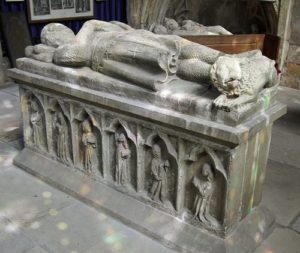There has been a church here since Saxon times. After the Norman Conquest, it was gifted to William of Calais, Prince Bishop of Durham. It became a collegiate church and the Prince Bishops established a palace here, well away from the Scottish border in times of trouble. A splendid new Minster was built in the C13th in the latest Decorated or Gothic style.
The first senior canon at the Minster was John of Howden who was locally regarded as a saint after his death in 1275 and his tomb became an important place of pilgrimage. Howden grew in wealth and importance.
The Dissolution of the Monasteries removed the canons and revenues and the Prince Bishops abandoned their palace and the Minster. The townsfolk continued to use the nave as their parish church. They were unable to maintain the east end of the church which was bricked off and choir, chancel and chapter house were left to fall into ruin. These are now in the care of English Heritage and there is no entry into the ruins.
In 1929 there was a disastrous fire when arsonists forced their way into the tower. This destroyed all the woodwork. The new choir stalls, altar and communion rails were made by Robert Thompson of Kilburn (the Mouse Man).
Howden Minster is a splendid building, especially seen from the east end when the ruins frame the present Minster Building with its tall square tower.
Inside is a very tall nave with pillars and pointed arches separating nave and side aisles. At the back is an octagonal carved font with very tall wooden spire cover. The hour glass pulpit with sounding board is beautifully carved. In the north aisle are two old wooden strong chests.
The wooden altar is set in front of a carved stone screen with ogee canopies containing statues. A carved wooden parclose screen separates it from the side chapel in the north transept. The simple stone altar top was part of the original stone high altar from the ruined east end of the Medieval Minster. High on the wall to the north of the chapel is the Royal Coat of Arms.
Between the chancel and south transept is a rather nice doorway with carved stone surround and statues on either side, which presumably leads into the now ruined part of the church. The south transept contains stone memorials and the floor tomb of Sir Peter Saltmarsh who served in the army of Edward I. He is in armour with his shield and feet resting on a lion. Propped up against the wall is a memorial brass but there is no information about this. There is also the old parish bier with the parish coffin dating from 1664 which was used to carry a corpse to the graveyard wrapped in a woollen or linen shroud for burial.
This is a good church with plenty of hatchments and some good Victorian glass. It is worth a visit and is open daily. There is on street parking or a small car park near the Minster.
Howden is a delightful small town with a lot of shops around the busy market place with its tubs of flowers.
There are more pictures “here.”:http://wasleys.org.uk/eleanor/churches/england/yorkshire/east_riding/east_two/howden/index.html










